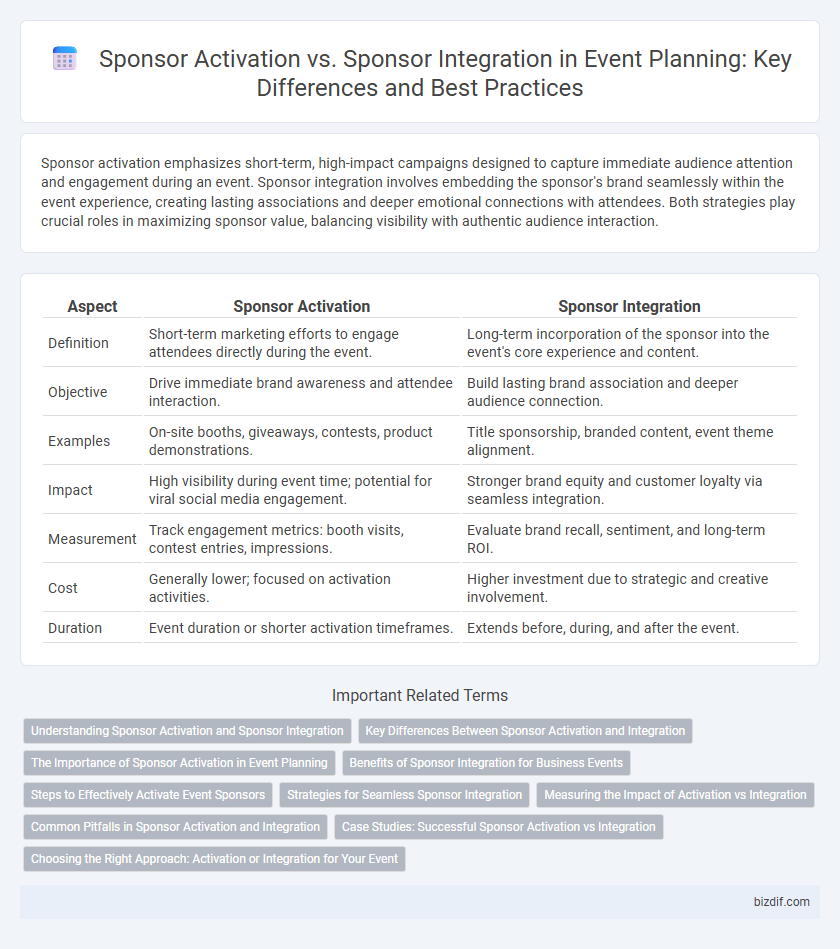Sponsor activation emphasizes short-term, high-impact campaigns designed to capture immediate audience attention and engagement during an event. Sponsor integration involves embedding the sponsor's brand seamlessly within the event experience, creating lasting associations and deeper emotional connections with attendees. Both strategies play crucial roles in maximizing sponsor value, balancing visibility with authentic audience interaction.
Table of Comparison
| Aspect | Sponsor Activation | Sponsor Integration |
|---|---|---|
| Definition | Short-term marketing efforts to engage attendees directly during the event. | Long-term incorporation of the sponsor into the event's core experience and content. |
| Objective | Drive immediate brand awareness and attendee interaction. | Build lasting brand association and deeper audience connection. |
| Examples | On-site booths, giveaways, contests, product demonstrations. | Title sponsorship, branded content, event theme alignment. |
| Impact | High visibility during event time; potential for viral social media engagement. | Stronger brand equity and customer loyalty via seamless integration. |
| Measurement | Track engagement metrics: booth visits, contest entries, impressions. | Evaluate brand recall, sentiment, and long-term ROI. |
| Cost | Generally lower; focused on activation activities. | Higher investment due to strategic and creative involvement. |
| Duration | Event duration or shorter activation timeframes. | Extends before, during, and after the event. |
Understanding Sponsor Activation and Sponsor Integration
Sponsor activation involves dynamic strategies that engage the event audience directly through interactive experiences, branded activities, and promotional campaigns designed to maximize sponsor visibility and engagement. Sponsor integration focuses on seamlessly embedding the sponsor's brand into the event's core elements, such as signage, digital content, and program components, creating a cohesive partnership that enhances the overall event atmosphere. Effective event planning balances sponsor activation and integration to ensure both immediate impact and lasting brand association for sponsors.
Key Differences Between Sponsor Activation and Integration
Sponsor activation involves specific promotional activities designed to engage attendees and create immediate brand awareness during the event, focusing on direct interaction and visibility. Sponsor integration encompasses deeper incorporation of the sponsor's brand into the core event elements, such as naming rights, event content, and long-term brand alignment within the event experience. Key differences include activation's emphasis on short-term engagement and measurable responses, while integration prioritizes strategic brand immersion and sustained association with the event's identity.
The Importance of Sponsor Activation in Event Planning
Sponsor activation drives direct engagement between brands and event attendees through interactive experiences and tailored marketing, enhancing brand visibility and recall. It transforms passive sponsorship into dynamic participation, generating measurable ROI and strengthening sponsor-event partnerships. Effective sponsor activation fosters deeper emotional connections, making sponsorship investments more impactful in event planning.
Benefits of Sponsor Integration for Business Events
Sponsor integration enhances brand visibility by embedding sponsor elements seamlessly throughout the event, creating authentic engagement with attendees. This approach drives higher ROI by fostering meaningful interactions and long-term brand loyalty, unlike one-off sponsor activations. Businesses benefit from increased exposure and stronger partnerships through strategic integration that aligns sponsor messaging with event objectives.
Steps to Effectively Activate Event Sponsors
Effective sponsor activation involves clearly defining goals, creating engaging brand experiences, and leveraging multi-channel marketing to maximize visibility and attendee interaction. Steps include aligning sponsor objectives with event themes, designing interactive activations that foster genuine engagement, and using data analytics to measure impact and optimize future activations. Prioritizing seamless brand integration enhances sponsor ROI and strengthens long-term partnership opportunities.
Strategies for Seamless Sponsor Integration
Effective sponsor integration involves embedding the sponsor's brand and message naturally within the event experience to enhance attendee engagement and brand recall. Strategies include co-creating interactive experiences, aligning sponsor activations with event themes, and utilizing data-driven insights to tailor messaging across digital and physical touchpoints. Seamless integration ensures sponsors add value without disrupting the flow, maximizing ROI and fostering lasting partnerships.
Measuring the Impact of Activation vs Integration
Measuring the impact of sponsor activation focuses on immediate engagement metrics such as attendee interactions, social media mentions, and on-site brand visibility during the event. In contrast, sponsor integration emphasizes long-term brand association and customer loyalty through seamless inclusion in event content, messaging, and overall experience. Data analytics tools track both activation's short-term ROI and integration's sustained brand equity across multiple channels.
Common Pitfalls in Sponsor Activation and Integration
Common pitfalls in sponsor activation include failing to align the brand message with event themes, resulting in ineffective audience engagement and missed ROI opportunities. In sponsor integration, challenges often arise from poor coordination between event organizers and sponsors, leading to disjointed experiences and diluted brand impact. Both activation and integration require clear communication and strategic planning to maximize sponsor visibility and attendee interaction.
Case Studies: Successful Sponsor Activation vs Integration
Case studies reveal that sponsor activation often centers on high-impact, short-term brand visibility through interactive booths, live demonstrations, and social media campaigns that engage attendees directly. Sponsor integration, in contrast, embeds brands seamlessly within the event experience, such as naming rights for stages, branded content collaboration, or exclusive product placements that create lasting impressions. Successful examples highlight activation by Coca-Cola at music festivals generating immediate buzz, while IBM's integrated approach in tech conferences builds long-term brand association through tailored keynote sponsorships and networking lounges.
Choosing the Right Approach: Activation or Integration for Your Event
Sponsor activation focuses on engaging audiences through distinct, memorable experiences that highlight the sponsor's brand during the event. Sponsor integration weaves the sponsor's identity seamlessly into the event's core elements, creating an immersive and cohesive brand presence. Choosing between activation and integration depends on event goals, audience engagement levels, and the desired depth of brand association.
Sponsor activation vs sponsor integration Infographic

 bizdif.com
bizdif.com